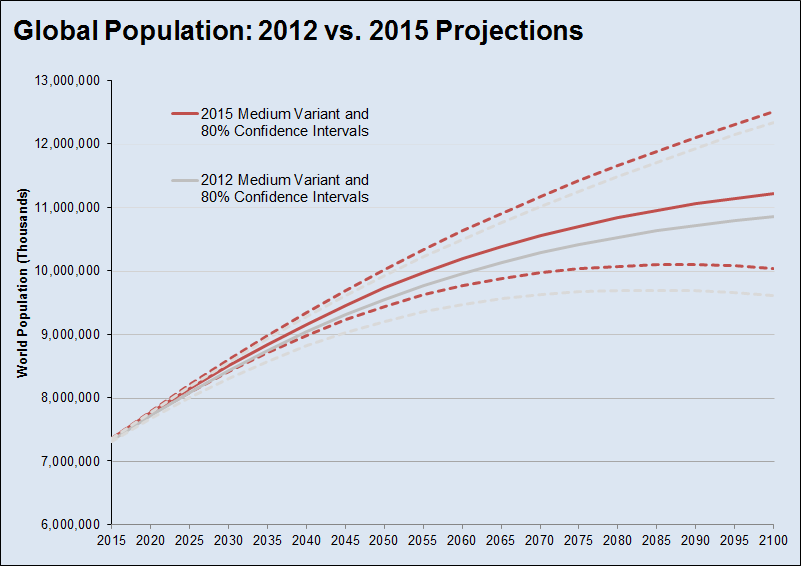-
Running Faster to Stand Still: New UN Population Projections Point to Challenges Ahead for SDGs
July 29, 2015 By Schuyler Null
In most parts of the world, population growth is stagnant, even declining slightly, part of a decades-long and nearly universal shift towards smaller, healthier families. But the places where growth is still rapid continue to defy expectations about when they will “catch up.”
The United Nation’s new medium variant projection for global population in 2050, released today, is 9.7 billion. That’s up from 9.6 billion people in the last revision and marks the fourth consecutive edition of the UN Population Division’s biannual report with a medium variant estimate higher than the last.
The population of Africa is projected to more than double by 2050More than half of global growth between now and 2050 is expected to occur in sub-Saharan Africa, where total population is projected to more than double. Asia, led by rapidly growing countries in the Middle East and South Asia but balanced by older populations in East Asia, follows behind.
Global population projections are heavily dependent on what happens in these few areas. This year’s revision incorporates new data from national censuses and demographic and health surveys, and the uptick in projections suggests a long-watched-for decline in fertility rates is proceeding more slowly than expected. The authors note that there is “significant uncertainty” in fertility projections even in the near term, which has important implications for the Sustainable Development Goals.
A Tale of Two Fertility Trends
Importantly, current projections include certain assumptions about government commitments to enable couples to choose the number and spacing of children, said John Wilmoth, director of the Population Division, at the report’s launch in New York. This applies not only to fertility declines in the least developed countries – they assume countries will continue to expand access to reproductive health services – but fertility increases in rich, aging countries.
In Europe and East Asia, where fertility rates are lowest, the time commitment and cost of raising children often influences couples’ decisions about the number to have. Government efforts to make day care and health care more affordable and make it easier for new mothers and fathers to leave and re-enter the workforce can therefore increase fertility rates.
Total fertility rates in all European countries are now below replacement level (2.1 children per woman) and in most cases have been so for decades. Europe’s overall total fertility rate is projected to increase slightly from 1.6 children per woman to 1.8 by 2050. Japan has the oldest median age in the world (51.5) and is one of only a few countries whose total population is projected to shrink by more than 15 percent by 2050.
Migration to Europe, despite the tensions it has evinced, will likely add a substantial portion of new people to some countries, though not enough for the continent to avoid a net decline in population between now and the end of the century. Between 2000 and 2015, high-income countries received an average of 4.1 million net migrants a year. In total, the UN projects migration will account for 82 percent of population growth in high-income countries between now and mid-century.
Migration will account for 82% of growth in high-income countriesIn developing countries it’s a different story. “To realize the substantial reductions in fertility projected in the medium variant,” write the authors, “it is essential to invest in reproductive health and family planning…so that women and couples can achieve their desired family size.” The UN estimates 22 percent of women in least developed countries have an unmet need for family planning.
A reduction in fertility is the first step to putting sub-Saharan Africa, South Asia, and other fast-growing areas on track for a “demographic dividend,” the report says, which can provide a boost in economic productivity to be harnessed for broad-based development as working age populations swell compared to dependents.
But this optimistic outcome also requires significant investment in services for today’s youth, history’s largest generation of young people. Sixty percent of people in Africa today are under 25 and the numbers for Latin America/the Caribbean and Asia are also high (43 and 40 percent, respectively). Providing these young people with education, opportunities for employment, and access to health care is crucial.
Population Touches on Everything
It’s not all gloomy news. The higher global population estimate for 2050 includes an 80 percent confidence interval between 9.4 and 10 billion, meaning there’s a good chance it could still be lower than the last projection (though also a chance it could be higher). And it’s not just rapid growth that is pushing up human populations, but increases in longevity. Life expectancy in Africa increased by six years over the last decade compared to just two over the previous decade. The total number of people over 60 worldwide is expected to more than double by 2050.
But the data does make clear that just to meet the UN’s latest projections, empowering and enabling today’s youth and expanding access to reproductive health services should be a major focus of the Sustainable Development Goals. We have to run faster to stand still. The two objectives are linked to one another – the fewer unwanted pregnancies there are, the easier it is to provide services to the youngest generation and vice versa – but also to a host of other development, environment, and even security challenges.
“The concentration of population growth in the poorest countries,” the report says, “will make it harder for those governments to eradicate poverty and inequality, combat hunger and malnutrition, expand education enrollment and health systems, improve the provision of basic services, and implement other elements of a sustainable development agenda to ensure that no-one is left behind.”
Sources: UN Population Division.
Photo Credit: Cairo, courtesy of Dominic Chavez/World Bank. Chart courtesy of Carley Chavara/Wilson Center.
Topics: Africa, aging, Asia, Caribbean, demography, development, education, Europe, family planning, featured, gender, global health, Japan, Latin America, Middle East, migration, population, poverty, SDGs, UN, youth
 A Publication of the Stimson Center.
A Publication of the Stimson Center.




